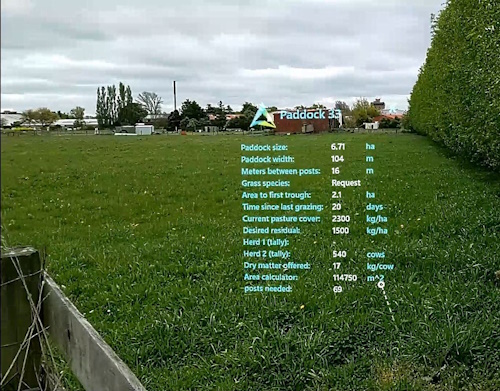
Example of paddock data shown in the AR headset after the farmer has looked at the paddock’s QR code at the gate (development: J. Scholten, 2022; example: Dairy Farm, Canterbury).
What if dairy farmers could know a paddock’s pasture cover and how much dry matter per cow it contained, just by looking at it? Or if they could access information about a cow’s body condition score the same way?
Augmented reality may one day make this, and more, possible – and Lincoln Agritech is starting to investigate how.
Working with DairyNZ, Lincoln Agritech is investigating augmented reality to see what difference it could make on dairy farms, including its potential benefits and limitations.
Augmented reality (AR) is a fast-growing technology that adds information to what people can perceive with their senses.
For example, using a headset, special spectacles, or earphones, it may provide data about an object or animal a person is looking at, such as the health or performance data of a cow.
“We are scoping out what is currently possible, and what may be possible in the near future,” says Abbas Jafari, one of Lincoln Agritech’s Precision Agriculture Scientists. “And we are also asking farmers, farm consultants, and veterinarians what they would find useful. They have been enthusiastic about the possibilities.”
After working with industry organisations, Lincoln Agritech selected three possible use cases to investigate. These are:
- How effective is AR in providing information about paddocks to support grazing management?
- How can AR help farm staff to learn how to use and maintain complex equipment such as tractors if reading through manuals is too time consuming?
- How can AR improve staff training and consistency in body condition scoring of cows?
Working with one Canterbury farmer, Lincoln Agritech intern Joost Scholten (from Wageningen University & Research in The Netherlands), has developed an app for a Hololens 2 headset that provides useful on-the-spot information about a paddock. The paddock gate is marked with a QR code. When the farmer looks at the QR code through the headset, the AR equipment identifies and pulls up useful data about the paddock (see image example of paddock view from the headset).
The next step is to work with a Lincoln University Dairy Farm to quantify how AR can help with cow body condition scoring.
“To bring this to farmers, by the end of this year we hope to have enough information to create a prototypical solution in a new project for industry to test,” says Armin Werner, Group Manager of Precision Agriculture at Lincoln Agritech. “The team has shown the possibilities of AR for dairy farming are really very exciting.”
Visitors to Fieldays will be able to see a demonstration of augmented reality on dairy farms at the Lincoln Agritech stand, site PD24. Fieldays is on from 30 November to 3 December at Mystery Creek.


